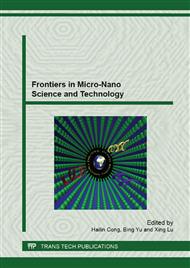p.260
p.269
p.275
p.281
p.302
p.306
p.312
p.319
p.325
Experimental Research on the Magnetic Mechanisms of Zn0.990Co0.010O Diluted Magnetic Semiconductor by Al-Doping
Abstract:
The effect of Al-doping concentration and sintered temperature (ST) on the structure and room-temperature ferromagnetism (RTFM) of Al-doped Zn0.990Co0.010O nanocrystals was investigated. The experimental results have indicated that all samples have RTFM and are composed of wurtzite ZnO with hexagonal structure without any secondary phases. The crystallization quality is positive related to ST and negative related to Al-doping concentration. When ST is higher than 800°C, the RTFM is dominated by the long rang coupling induced from the conductive carriers of Al3+, since it is increasing with the increase of Al-doping concentration and grain sizes. When ST is lower than 800°C, the RTFM is dominated by localized carriers from oxygen vacancies, since the maximum RTFM belongs to the sample which has the lowest parameters of unit cell.
Info:
Periodical:
Pages:
302-305
Citation:
Online since:
April 2014
Authors:
Price:
Сopyright:
© 2014 Trans Tech Publications Ltd. All Rights Reserved
Share:
Citation:


